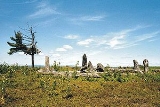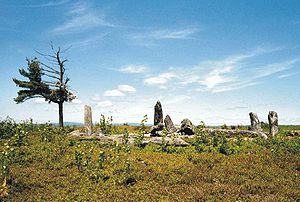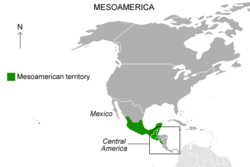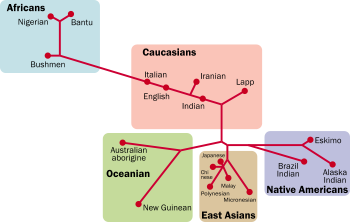
Archaeology of the Americas
Encyclopedia

Archaeology
Archaeology, or archeology , is the study of human society, primarily through the recovery and analysis of the material culture and environmental data that they have left behind, which includes artifacts, architecture, biofacts and cultural landscapes...
of North America
North America
North America is a continent wholly within the Northern Hemisphere and almost wholly within the Western Hemisphere. It is also considered a northern subcontinent of the Americas...
(Mesoamerica
Mesoamerica
Mesoamerica is a region and culture area in the Americas, extending approximately from central Mexico to Belize, Guatemala, El Salvador, Honduras, Nicaragua, and Costa Rica, within which a number of pre-Columbian societies flourished before the Spanish colonization of the Americas in the 15th and...
included), Central America
Central America
Central America is the central geographic region of the Americas. It is the southernmost, isthmian portion of the North American continent, which connects with South America on the southeast. When considered part of the unified continental model, it is considered a subcontinent...
, South America
South America
South America is a continent situated in the Western Hemisphere, mostly in the Southern Hemisphere, with a relatively small portion in the Northern Hemisphere. The continent is also considered a subcontinent of the Americas. It is bordered on the west by the Pacific Ocean and on the north and east...
and the Caribbean
Caribbean
The Caribbean is a crescent-shaped group of islands more than 2,000 miles long separating the Gulf of Mexico and the Caribbean Sea, to the west and south, from the Atlantic Ocean, to the east and north...
. This includes the study of pre-historic/Pre-Columbian
Pre-Columbian
The pre-Columbian era incorporates all period subdivisions in the history and prehistory of the Americas before the appearance of significant European influences on the American continents, spanning the time of the original settlement in the Upper Paleolithic period to European colonization during...
and historic indigenous American peoples
Indigenous peoples of the Americas
The indigenous peoples of the Americas are the pre-Columbian inhabitants of North and South America, their descendants and other ethnic groups who are identified with those peoples. Indigenous peoples are known in Canada as Aboriginal peoples, and in the United States as Native Americans...
.
Archaeological time periods
One of the most enduring classifications of archaeological cultures was established in Gordon WilleyGordon Willey
Gordon Randolph Willey was an American archaeologist famous for his fieldwork in South and Central America as well as the southeastern United States...
and Philip Phillips
Philip Phillips (archaeologist)
Philip Phillips was an influential archaeologist in the United States during the 20th century. Although his first graduate work was in architecture, he later received a doctorate from Harvard University under advisor Alfred Marston Tozzer...
' 1958 book Method and Theory in American Archaeology. They divided the archaeological record
Archaeological record
The archaeological record is the body of physical evidence about the past. It is one of the most basic concepts in archaeology, the academic discipline concerned with documenting and interpreting the archaeological record....
in the Americas into five phases.

Mesoamerican chronology
Mesoamerican chronology divides the history of pre-Columbian Mesoamerica into several periods: the Paleo-Indian , the Archaic , the Preclassic , the Classic , and the Postclassic...
, the divisions have been replaced in most of North America by more local classifications with a more elaborated breakdown of periods of time. See: List of archaeological periods (North America)
- The Lithic stageLithic stageIn the sequence of North American prehistoric cultural stages first proposed by Gordon Willey and Philip Phillips in 1958, the Lithic stage was the earliest period of human occupation in the Americas, accruing during the Late Pleistocene period, to time before 8,000 B.C....
/or Paleo-Indian period
- Defined initially as a big-game hunting adaptation. In most places, this can be dated to before 8000 BC. Examples include the Clovis cultureClovis cultureThe Clovis culture is a prehistoric Paleo-Indian culture that first appears 11,500 RCYBP , at the end of the last glacial period, characterized by the manufacture of "Clovis points" and distinctive bone and ivory tools...
and Folsom traditionFolsom traditionThe Folsom Complex is a name given by archaeologists to a specific Paleo-Indian archaeological culture that occupied much of central North America...
groups.- The Archaic stage
- Defined as cultures relying primarily on increasing intensive collecting of wild resources, after the decline of the big-game hunting lifestyle. Typically Archaic cultures can be dated from 8000 BC to 1000 BC. Examples include the Archaic Southwest, the Arctic small tool traditionArctic small tool traditionThe Arctic Small Tool tradition is a broad cultural entity that developed along the Alaska Peninsula, round Bristol Bay, and on the eastern shores of the Bering Strait around 2500 BC...
, the Poverty PointPoverty PointPoverty Point is a prehistoric earthworks of the Poverty Point culture, now a historic monument located in the Southern United States. It is from the current Mississippi River, and situated on the edge of Maçon Ridge, near the village of Epps in West Carroll Parish, Louisiana.Poverty Point...
culture, and the Chan-ChanChan-Chanthumb|right|300px|View of the beach of Chan-Chan and the forested Tren-Tren peninsula south of the main archaeological site.Chan-Chan is an archaeological site and beach on the coast of the commune of Mehuín in southern Chile. Chan-Chan is known to have been inhabited by hunter-gatherers during...
culture in southern Chile.- The Formative stageFormative stageThe Formative Stage or "Neo-Indian period" is an archaeological term describing a particular developmental level. This stage from 1000 BCE to 500 CE is the third of five stages defined by Gordon Willey and Philip Phillips' 1958 book Method and Theory in American Archaeology.Cultures of the...
- The Formative stage
- Defined as "village agriculture" based. Most of these can be dated from 1000 BC to AD 500. Examples include the Dorset cultureDorset cultureThe Dorset culture was a Paleo-Eskimo culture that preceded the Inuit culture in Arctic North America. It has been defined as having four phases, with distinct technology related to the people's hunting and tool making...
, ZapotecZapotec civilizationThe Zapotec civilization was an indigenous pre-Columbian civilization that flourished in the Valley of Oaxaca of southern Mesoamerica. Archaeological evidence shows their culture goes back at least 2500 years...
culture, MimbresMimbresMimbres may refer to:* Mimbres culture , a subdivision of Mogollon culture* Mimbres pottery, a particular style of pottery decoration from the Mimbres culture* Mimbres Valley AVA, an American Viticultural Area in southwestern New Mexico...
, OlmecOlmecThe Olmec were the first major Pre-Columbian civilization in Mexico. They lived in the tropical lowlands of south-central Mexico, in the modern-day states of Veracruz and Tabasco....
, WoodlandWoodland periodThe Woodland period of North American pre-Columbian cultures was from roughly 1000 BCE to 1000 CE in the eastern part of North America. The term "Woodland Period" was introduced in the 1930s as a generic header for prehistoric sites falling between the Archaic hunter-gatherers and the...
and Mississippian cultureMississippian cultureThe Mississippian culture was a mound-building Native American culture that flourished in what is now the Midwestern, Eastern, and Southeastern United States from approximately 800 CE to 1500 CE, varying regionally....
s.- The Classic stageClassic stageThe Classic Stage is an archaeological term describing a particular developmental level dating from AD 500 to 1200. This stage is the fourth of five stages defined by Gordon Willey and Philip Phillips' 1958 book Method and Theory in American Archaeology....
- The Classic stage
- Defined as "early civilizations," and typically dating from AD 500 to 1200. Willey and Phillips considered only cultures from Mesoamerica and Peru to have achieved this level of complexity. Examples include the early MayaMaya civilizationThe Maya is a Mesoamerican civilization, noted for the only known fully developed written language of the pre-Columbian Americas, as well as for its art, architecture, and mathematical and astronomical systems. Initially established during the Pre-Classic period The Maya is a Mesoamerican...
and the ToltecToltecThe Toltec culture is an archaeological Mesoamerican culture that dominated a state centered in Tula, Hidalgo in the early post-classic period of Mesoamerican chronology...
.- The Post-Classic stagePost-Classic stageThe Post-Classic Stage is an archaeological term describing a particular developmental level. This stage is the fifth of five stages defined by Gordon Willey and Philip Phillips' 1958 book Method and Theory in American Archaeology....
- The Post-Classic stage
- Defined as "later prehispanic civilizations" and typically dated from AD 1200 onward. The late MayaMaya civilizationThe Maya is a Mesoamerican civilization, noted for the only known fully developed written language of the pre-Columbian Americas, as well as for its art, architecture, and mathematical and astronomical systems. Initially established during the Pre-Classic period The Maya is a Mesoamerican...
and the AztecAztecThe Aztec people were certain ethnic groups of central Mexico, particularly those groups who spoke the Nahuatl language and who dominated large parts of Mesoamerica in the 14th, 15th and 16th centuries, a period referred to as the late post-classic period in Mesoamerican chronology.Aztec is the...
cultures were Post-Classic.
Archaeology in the United States
Since 1990, in the United StatesUnited States
The United States of America is a federal constitutional republic comprising fifty states and a federal district...
, physical anthropology
Physical anthropology
Biological anthropology is that branch of anthropology that studies the physical development of the human species. It plays an important part in paleoanthropology and in forensic anthropology...
and archaeological investigations based on the study of human remains are complicated by the Native American Graves Protection and Repatriation Act
Native American Graves Protection and Repatriation Act
The Native American Graves Protection and Repatriation Act , Pub. L. 101-601, 25 U.S.C. 3001 et seq., 104 Stat. 3048, is a United States federal law passed on 16 November 1990 requiring federal agencies and institutions that receive federal funding to return Native American "cultural items" to...
, (NAGPRA), which provides for the bodies of Native Americans and associated grave goods
Grave goods
Grave goods, in archaeology and anthropology, are the items buried along with the body.They are usually personal possessions, supplies to smooth the deceased's journey into the afterlife or offerings to the gods. Grave goods are a type of votive deposit...
to be turned over to the recognized tribal body most legally affiliated with the remains. In some cases, notably, that of Kennewick Man
Kennewick Man
Kennewick Man is the name for the skeletal remains of a prehistoric man found on a bank of the Columbia River in Kennewick, Washington, USA, on July 28, 1996...
, these laws have been subject to close judicial scrutiny and great intellectual conflict.

Archaeology in Mesoamerica
Mesoamerica or Meso-America is a regionRegion
Region is most commonly found as a term used in terrestrial and astrophysics sciences also an area, notably among the different sub-disciplines of geography, studied by regional geographers. Regions consist of subregions that contain clusters of like areas that are distinctive by their uniformity...
and culture area
Cultural area
A cultural area or culture area is a region with one relatively homogeneous human activity or complex of activities . These areas are primarily geographical, not historical , and they are not considered equivalent to Kulturkreis .-Development:A culture area is a concept in cultural anthropology...
in the Americas
Americas
The Americas, or America , are lands in the Western hemisphere, also known as the New World. In English, the plural form the Americas is often used to refer to the landmasses of North America and South America with their associated islands and regions, while the singular form America is primarily...
, extending approximately from central Mexico
Mexico
The United Mexican States , commonly known as Mexico , is a federal constitutional republic in North America. It is bordered on the north by the United States; on the south and west by the Pacific Ocean; on the southeast by Guatemala, Belize, and the Caribbean Sea; and on the east by the Gulf of...
to Honduras
Honduras
Honduras is a republic in Central America. It was previously known as Spanish Honduras to differentiate it from British Honduras, which became the modern-day state of Belize...
and Nicaragua
Nicaragua
Nicaragua is the largest country in the Central American American isthmus, bordered by Honduras to the north and Costa Rica to the south. The country is situated between 11 and 14 degrees north of the Equator in the Northern Hemisphere, which places it entirely within the tropics. The Pacific Ocean...
, within which a number of pre-Columbian
Pre-Columbian
The pre-Columbian era incorporates all period subdivisions in the history and prehistory of the Americas before the appearance of significant European influences on the American continents, spanning the time of the original settlement in the Upper Paleolithic period to European colonization during...
societies
Society
A society, or a human society, is a group of people related to each other through persistent relations, or a large social grouping sharing the same geographical or virtual territory, subject to the same political authority and dominant cultural expectations...
flourished before the Spanish colonization of the Americas
Spanish colonization of the Americas
Colonial expansion under the Spanish Empire was initiated by the Spanish conquistadores and developed by the Monarchy of Spain through its administrators and missionaries. The motivations for colonial expansion were trade and the spread of the Christian faith through indigenous conversions...
in the 15th and 16th centuries. Prehistoric groups in this area are characterized by agricultural
Agriculture
Agriculture is the cultivation of animals, plants, fungi and other life forms for food, fiber, and other products used to sustain life. Agriculture was the key implement in the rise of sedentary human civilization, whereby farming of domesticated species created food surpluses that nurtured the...
villages and large ceremonial and politico-religious capitals This culture area included some of the most complex and advanced culture
Culture
Culture is a term that has many different inter-related meanings. For example, in 1952, Alfred Kroeber and Clyde Kluckhohn compiled a list of 164 definitions of "culture" in Culture: A Critical Review of Concepts and Definitions...
s of the Americas, including the Olmec
Olmec
The Olmec were the first major Pre-Columbian civilization in Mexico. They lived in the tropical lowlands of south-central Mexico, in the modern-day states of Veracruz and Tabasco....
, Teotihuacan
Teotihuacan
Teotihuacan – also written Teotihuacán, with a Spanish orthographic accent on the last syllable – is an enormous archaeological site in the Basin of Mexico, just 30 miles northeast of Mexico City, containing some of the largest pyramidal structures built in the pre-Columbian Americas...
, the Maya
Maya civilization
The Maya is a Mesoamerican civilization, noted for the only known fully developed written language of the pre-Columbian Americas, as well as for its art, architecture, and mathematical and astronomical systems. Initially established during the Pre-Classic period The Maya is a Mesoamerican...
, and the Aztec
Aztec
The Aztec people were certain ethnic groups of central Mexico, particularly those groups who spoke the Nahuatl language and who dominated large parts of Mesoamerica in the 14th, 15th and 16th centuries, a period referred to as the late post-classic period in Mesoamerican chronology.Aztec is the...
.
Humans entering the Americas
Settlement of the Americas address the central question of when and how humans reached the Americas. The earliest definite human peoples visible in the archaeological record throughout the Americas are today known as the Paleo-Indians.Pre-Columbian era
The Pre-Columbian eraPre-Columbian era
The pre-Columbian era incorporates all period subdivisions in the history and prehistory of the Americas before the appearance of significant European influences on the American continents, spanning the time of the original settlement in the Upper Paleolithic period to European colonization during...
incorporates all period subdivisions in the history of the Americas
History of the Americas
The history of the Americas is the collective history of the American landmass, which includes North and South America, as well as Central America and the Caribbean. It begins with people migrating to these areas from Asia during the height of an Ice Age...
before the appearance of significant European
Europe
Europe is, by convention, one of the world's seven continents. Comprising the westernmost peninsula of Eurasia, Europe is generally 'divided' from Asia to its east by the watershed divides of the Ural and Caucasus Mountains, the Ural River, the Caspian and Black Seas, and the waterways connecting...
influences on the Americas
Americas
The Americas, or America , are lands in the Western hemisphere, also known as the New World. In English, the plural form the Americas is often used to refer to the landmasses of North America and South America with their associated islands and regions, while the singular form America is primarily...
, spanning the time from the original migration to the New World in the Upper Paleolithic
Upper Paleolithic
The Upper Paleolithic is the third and last subdivision of the Paleolithic or Old Stone Age as it is understood in Europe, Africa and Asia. Very broadly it dates to between 40,000 and 10,000 years ago, roughly coinciding with the appearance of behavioral modernity and before the advent of...
up to the European colonization of the Americas
European colonization of the Americas
The start of the European colonization of the Americas is typically dated to 1492. The first Europeans to reach the Americas were the Vikings during the 11th century, who established several colonies in Greenland and one short-lived settlement in present day Newfoundland...
during the Early Modern period
Early modern period
In history, the early modern period of modern history follows the late Middle Ages. Although the chronological limits of the period are open to debate, the timeframe spans the period after the late portion of the Middle Ages through the beginning of the Age of Revolutions...
.
While technically referring to the era before Christopher Columbus
Christopher Columbus
Christopher Columbus was an explorer, colonizer, and navigator, born in the Republic of Genoa, in northwestern Italy. Under the auspices of the Catholic Monarchs of Spain, he completed four voyages across the Atlantic Ocean that led to general European awareness of the American continents in the...
' voyages of 1492 to 1504, in practice the term usually includes the history of American indigenous cultures
Indigenous peoples of the Americas
The indigenous peoples of the Americas are the pre-Columbian inhabitants of North and South America, their descendants and other ethnic groups who are identified with those peoples. Indigenous peoples are known in Canada as Aboriginal peoples, and in the United States as Native Americans...
until they were conquered or significantly influenced by Europeans, even if this happened decades or even centuries after Columbus' initial landing.
Archaeogenetics

Molecular genetics
Molecular genetics
Molecular genetics is the field of biology and genetics that studies the structure and function of genes at a molecular level. The field studies how the genes are transferred from generation to generation. Molecular genetics employs the methods of genetics and molecular biology...
study suggests that surviving Amerindian
Indigenous peoples of the Americas
The indigenous peoples of the Americas are the pre-Columbian inhabitants of North and South America, their descendants and other ethnic groups who are identified with those peoples. Indigenous peoples are known in Canada as Aboriginal peoples, and in the United States as Native Americans...
populations derived from a theoretical single founding population
Founder effect
In population genetics, the founder effect is the loss of genetic variation that occurs when a new population is established by a very small number of individuals from a larger population. It was first fully outlined by Ernst Mayr in 1942, using existing theoretical work by those such as Sewall...
, possibly from only 50 to 70 genetic contributors Preliminary research, restricted to only 9 genomic regions (or loci
Locus (genetics)
In the fields of genetics and genetic computation, a locus is the specific location of a gene or DNA sequence on a chromosome. A variant of the DNA sequence at a given locus is called an allele. The ordered list of loci known for a particular genome is called a genetic map...
) have shown a genetic link between original Americas and Asia populations. The study does not address the question of separate migrations for these groups, and excludes other DNA data-sets.
The American Journal of Human Genetics
American Journal of Human Genetics
The American Journal of Human Genetics is a medical journal in the field of human genetics. Since its inception in 1948 by the American Society of Human Genetics, the journal has provided a record of research and review relating to heredity in humans and to the application of genetic principles in...
released an article in 2007 stating "Here we show, by using 86 complete mitochondrial genomes, that all Indigenous American haplogroups, including Haplogroup X (mtDNA)
Haplogroup X (mtDNA)
In human mitochondrial genetics, Haplogroup X is a human mitochondrial DNA haplogroup. It has a widespread global distribution but no major regions of distinct localization.-Origin:...
, were part of a single founding population." Amerindian groups in the Bering Strait region exhibit perhaps the strongest DNA or mitochondrial DNA relations to Siberian peoples
Indigenous peoples of Siberia
Including the Russian Far East, the population of Siberia numbers just above 40 million people.As a result of the 17th to 19th century Russian conquest of Siberia and the subsequent population movements during the Soviet era, the demographics of Siberia today is dominated by native speakers of...
. The genetic diversity of Amerindian indigenous groups increase with distance from the assumed entry point into the Americas. Certain genetic diversity patterns from West to East suggest at least some coastal migration events. Geneticists have variously estimated that peoples of Asia and the Americas were part of the same population from 42,000 to 21,000 years ago.

